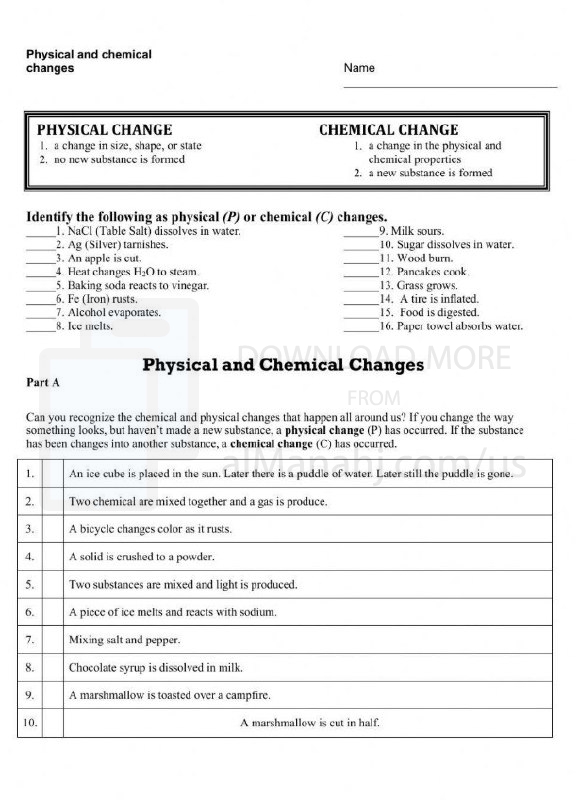| You are here: Almanahj Website ⇒ American curriculum ⇒ 5th Grade ⇒ Physics ⇒ Term 1 | ||
|---|---|---|
Worksheet about Changes in Matter | ||
|---|---|---|
| Subject: Physics | ||
| 5th Grade | ||
| Term 1 | ||
| Year: 2023/2024 | ||
| Size: 245.6KB | ||
| Number of clicks: 120 | ||
| Publish date:November 08, 2023 | ||
| Added by: Eman | ||
| Last download date: 2024-09-12 11:40:01 | ||
| Updated by: Eman9966 on 2023-11-08 06:34:57 | By: theodor Adal Alvarez | |
File info: In physics, changes in matter refer to the physical transformations that substances can undergo. Matter can change in various ways, including changes in state, composition, or physical properties. Here are descriptions of different types of changes in matter:1. Phase Change: Matter can undergo phase changes, also known as state changes, when it transitions from one state to another. The three primary states of matter are solid, liquid, and gas. Examples of phase changes include: - Melting: The change from a solid to a liquid state, typically due to an increase in temperature. - Freezing: The change from a liquid to a solid state, usually caused by a decrease in temperature. - Vaporization: The change from a liquid to a gaseous state. This can occur through evaporation (slow vaporization at the surface) or boiling (rapid vaporization throughout the liquid). - Condensation: The change from a gaseous to a liquid state, often caused by cooling. - Sublimation: The change from a solid directly to a gaseous state, bypassing the liquid phase. An example is the sublimation of dry ice, which turns directly into carbon dioxide gas. 2. Chemical Reaction: Matter can also undergo chemical changes, resulting in the formation or breaking of chemical bonds and the creation of new substances. Chemical reactions involve the rearrangement of atoms and molecules. Some examples include: - Combustion: The reaction between a substance and oxygen, resulting in the release of heat and often producing new compounds, such as burning wood or gasoline. - Oxidation: The reaction of a substance with oxygen or another oxidizing agent, leading to chemical changes and often causing rust or tarnish. - Acid-Base Reactions: The reaction between an acid and a base, resulting in the formation of water and a salt compound. - Decomposition: The breakdown of a compound into simpler substances, such as the decomposition of hydrogen peroxide into water and oxygen gas. 3. Physical Property Changes: Matter can also undergo changes in its physical properties without any change in composition. Examples include changes in shape, size, density, or state due to external factors such as temperature, pressure, or applied forces. - Changes in Shape: Matter can be molded, stretched, compressed, or deformed, resulting in changes in its shape or form. - Changes in Size: Matter can expand or contract in response to changes in temperature. For example, metals expand when heated and contract when cooled. - Changes in Density: Matter can change in density due to changes in temperature or pressure. For instance, gases become more dense at lower temperatures or higher pressures. Understanding changes in matter is fundamental to the study of physics, as it helps describe and explain various phenomena and processes, including the behavior of substances under different conditions and the interactions between different types of matter. | ||
| Downloading link Worksheet about Changes in Matter |
|---|
|
1699424963.pdf
The file is being prepared for download
|
| File images |
|---|
 |